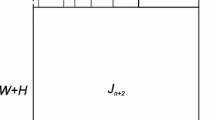Abstract
This paper introduces an approach to solving combinatorial optimization problems on partially ordered sets by the reduction to searching source-sink paths in the related transversal graphs. Different techniques are demonstrated in application to finding consistent supersequences, merging partially ordered sets, and machine scheduling with precedence constraints. Extending the approach to labeled partially ordered sets we also propose a solution for the smallest superplan problem and show its equivalence to the well studied coarsest regular refinement problem. For partially ordered sets of a fixed width the number of vertices in their transversal graphs is polynomial, so the reduction allows us easily to establish that many related problems are solvable in polynomial or pseudopolynomial time. For example, we establish that the longest consistent supersequence problem with a fixed number of given strings can be solved in polynomial time, and that the precedence-constrained release-date maximum- or total-cost preemptive or nonpreemptive job-shop scheduling problem with a fixed number of jobs can be solved in pseudopolynomial time. We also show that transversal graphs can be used to generalize and strengthen similar results obtained earlier by dynamic programming.
Similar content being viewed by others
References
S.B. Ackers, "A graphical approach to production scheduling problems," Oper. Res., vol. 4, pp. 244–245, 1956.
M. Aigner, Combinatorial Theory, Springer-Verlag, 1979.
P. Brucker, "A polynomial algorithm for the two machine job-shop scheduling problem with a fixed number of jobs," OR Spectrum, vol. 16, pp. 5–7, 1994.
P. Brucker, Scheduling Algorithms, Springer: Berlin, 1995.
P. Brucker and A. Kr¨amer, "Polynomial algorithms for resource-constrained and multiprocessor task scheduling problems," EJOR, vol. 90, pp. 214–226, 1996.
P. Brucker, S.A. Kravchenko, and Y.N. Sotskov, "Preemptive job-shop scheduling problems with a fixed number of jobs," Mathematical Methods of Operations Research, vol. 49, pp. 41–76, 1999.
D.E. Foulser, M. Li, and Q. Yang, "Theory and algorithms for plan merging," Artificial Intelligence, vol. 57, pp.143–181, 1992.
C. Fraser, "Consistent subsequences and supersequences," Theoret. Comput. Sci., vol. 165, pp. 233–246, 1996.
C.B. Fraser, R.W. Irving, and M. Middendorf, "Maximal common subsequences and minimal common supersequences," Information and Computation, vol. 124, no. 2, pp. 145–153, 1996.
M.R. Garey and D.S. Johnson, Computers and Intractability: AGuide to the Theory of NP-Completeness, Freeman: San Francisco, 1979.
K. Hakata and H. Imai, "The longest common subsequence problem for small alphabet size between many strings," Lect. Notes in Comput. Sci., vol. 650, pp. 469–478, 1992.
W.J. Hsu and M.W. Du, "New algorithm for the LCS problem," J. Comput. and System Sci., vol. 29, pp. 133–152, 1984.
R.W. Irving and C.B. Fraser, "Two algorithms for the longest common subsequence of 3 (or more) strings," Lect. Notes in Comput. Sci., vol. 644, pp. 214–229, 1992.
S.Y. Itoga, "The string merging problem," BIT, vol. 21, pp. 20–30, 1981.
T. Jiang and M. Li, "On the complexity of learning strings and sequences," Theoret. Comput. Sci., vol. 119, pp. 363–371, 1992.
A. Kr¨amer, "Scheduling multiprocessor tasks on dedicated processors," Diss., Fachbereich Mathematik/ Informatik, Universit¨at Osnabr¨uck, Osnabr¨uck, 1995.
E.L. Lawler, Combinatorial Optimization: Networks and Matroids, Holt, Rinehart andWinston: New York, 1976.
E.L. Lawler, J.K. Lenstra, A.H.G. Rinnooy Kan, and D.B. Shmoys, "Sequencing and scheduling: algorithms and complexity," in Handbook on Operations Research and Management Science, Vol. 4: Logistics of Production and Inventory, S.C. Graves, A.H.G. Rinnooy Kan, and P. Zipkin (Eds.), Elsevier Science Publishers, B.V.: Amsterdam, pp. 445–552, 1993.
W. Meyer, "Geometrische Methoden zur L¨osung von Job-shop Problemen und derenVerallgemeinerungen," Diss., Faculty of Mathematics and Computer Science, University of Osnabr¨uck, 1992. (German).
M. Middendorf, "On finding minimal, maximal and consistent sequences over a binary alphabet," Theoret. Comput. Sci., vol. 145, pp. 317–327, 1994.
M. Middendorf and V.G. Timkovsky, "Transversal Graphs in Plan Merging and Related Problems," in Proc. Third International Symposium on Operations Research and Its Applications (ISORA'98), Lecture Notes in Operations Research 3, World Publishing. Corp., Beijing, 1998, pp. 60–74.
R.H. M¨ohring, "Computationally tractable classes of ordered sets," in Algorithms and Order, I. Rival (Ed.), Kluwer Academic: Dordrecht, pp. 105–193, 1989.
A.R. Rubinov and V.G. Timkovsky, "Nonsimilarity combinatorial problems," I, BioSystems, vol. 30, 1993, pp. 81–92, II, in Computer Genetics, P.A. Pevzner and M.S. Gelfand (Ed.), Elsevier, 1993, pp. 81–92.
A.R. Rubinov and V.G. Timkovsky, "String noninclusion optimization problems," SIAM J. Discrete Math., vol. 11, pp. 456–467, 1998.
Yu.N. Sotskov, "The complexity of shop scheduling problems with two or three jobs," EJOR, vol. 53, pp. 326–336, 1991.
V.G. Timkovsky, "Complexity of common subsequence and supersequence problems and related problems," Kibernetika, no. 5, pp. 1–13, 1989 (in Russian); English transl. in Cybernetics, vol. 25, pp. 565–580, 1990.
L. Zhang, "On the approximation of longest common non-supersequences and shortest common nonsubsequences," Theoret. Comput. Sci., vol. 143, pp. 353–362, 1995.
Author information
Authors and Affiliations
Corresponding author
Rights and permissions
About this article
Cite this article
Middendorf, M., Timkovsky, V.G. Transversal Graphs for Partially Ordered Sets: Sequencing, Merging and Scheduling Problems. Journal of Combinatorial Optimization 3, 417–435 (1999). https://doi.org/10.1023/A:1009827520712
Issue Date:
DOI: https://doi.org/10.1023/A:1009827520712




